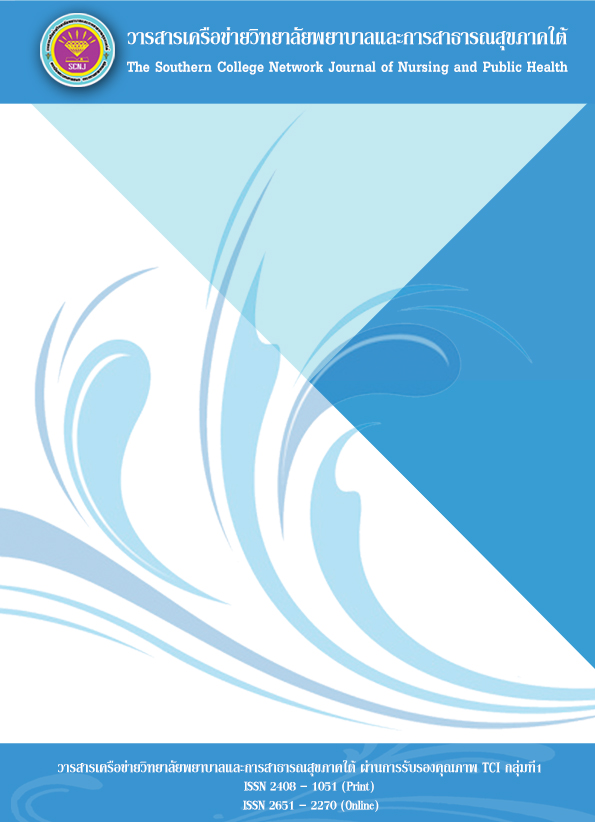การศึกษาประสิทธิผลของการนวดด้วยน้ำคั้นไพลและน้ำมันไพลต่ออาการปวดกล้ามเนื้อคอ บ่า ไหล่ ในนักศึกษาวิทยาลัยเทคโนโลยีทางการแพทย์และสาธารณสุข กาญจนาภิเษก
คำสำคัญ:
น้ำคั้นไพล, น้ำมันไพล, อาการปวดกล้ามเนื้อคอ บ่า ไหล่บทคัดย่อ
การวิจัยกึ่งทดลองครั้งนี้ เพื่อศึกษาและเปรียบเทียบประสิทธิผลของการนวดด้วยน้ำคั้นจากไพลและน้ำมันไพลต่ออาการปวดกล้ามเนื้อคอ บ่า ไหล่ กลุ่มตัวอย่างเป็นนักศึกษาวิทยาลัยเทคโนโลยีทางการแพทย์และสาธารณสุข กาญจนาภิเษก จำนวน 60 ราย เลือกกลุ่มตัวอย่างแบบจำเพาะเจาะจง เครื่องมือที่ใช้ในการศึกษาคือ แบบวัดระดับความปวด (NRS) เครื่องวัดระดับความรู้สึกกดเจ็บ (Algometer) เครื่องวัดองศาการเคลื่อนไหวของข้อ (Inclinometer) และแบบบันทึกข้อมูลการทดลอง สถิติที่ใช้ในการวิเคราะห์ข้อมูล ได้แก่ ค่าความถี่ ร้อยละ ค่าเฉลี่ย ค่าเบี่ยงเบนมาตราฐาน และสถิติ t-test ผลการวิจัยพบว่า
1. หลังการนวดด้วยน้ำคั้นไพลมีผลทำให้ระดับอาการปวดลดลง ระดับความรู้สึกกดเจ็บเพิ่มขึ้นและองศาการเคลื่อนไหวคอเพิ่มขึ้นอย่างมีนัยสำคัญทางสถิติที่ .05
2. หลังการนวดด้วยน้ำมันไพลมีผลทำให้ระดับอาการปวดลดลง ระดับความรู้สึกกดเจ็บเพิ่มขึ้นและองศาการเคลื่อนไหวคอเพิ่มขึ้นอย่างมีนัยสำคัญทางสถิติที่ .05
3. การนวดด้วยน้ำคั้นไพลและน้ำมันไพลมีผลต่อ ระดับอาการปวด ระดับความรู้สึกกดเจ็บเและองศาการเคลื่อนไหวคอไม่แตกต่างกันอย่างมีนัยสำคัญทางสถิติที่ .05
ดังนั้น น้ำคั้นไพลและน้ำมันไพลสามารถใช้แทนกันได้ เพราะมีผลต่ออาการปวดกล้ามเนื้อไม่แตกต่างกัน ซึ่งน้ำคั้นไพลเป็นภูมิปัญญาดั้งเดิมของไทย เมื่อทาผิวไม่เกิดความเหนียวเหนอะหนะ การใช้น้ำคั้นไพลจึงสามารถเป็นทางเลือกในการรักษาอาการปวดคอ บ่า ไหล่ ตลอดจนพัฒนาเป็นผลิตภัณฑ์ที่มีคุณภาพมากยิ่งขึ้น
เอกสารอ้างอิง
Bunpean, A. (2016). Health Survey of Kanchanabhishek Institute of Medical and Public Health Technology Students. Kanchanabhishek Institute of Medical and Public Health Technology. (in Thai)
Chaiklieng, S., & Nithithamthada, R. (2016). Factors Associated with Neck, Shoulder and Back Pain among Dental Personnel of Government Hospitals in Khon Kaen Province. Journal of Public Health, 46(1), 42-56. (in Thai)
Chokevivat, V. (2012). Phlai. Journal of Thai Traditional & Alternative Medicine, 10(1), 52-56.
Chotigavanich, C. (1988). Physical Examination in Orthopaedics. Faculty of Medicine Siriraj Hospital, Mahidol University, Bangkok. (in Thai)
Chuakul, W. (2005). Taxonomy of Medicinal Plants. Bangkok: Varanon-Enterprise.
De Cássia, da., Silveira, e., Sá, R., Andrade, L. N., & de Sousa, D. P. (2013). A Review on Anti-Inflammatory Activity of Monoterpenes. Molecules, 18(1), 1227-54. DOI: 10.3390/molecules18011227.
Glass, G. V. (1979). Primary, Secondary, and Meta-Analysis of Research. Educational Researcher, 5(10), 3-8.
Held, S., Schieberle, P., & Somoza, V. (2007). Characterization of α-Terpineol as an Anti-Inflammatory Component of Orange Juice by in Vitro Studies Using Oral Buccal Cells. J. Agric. Food Chem, 55(20), 8040–8046. DOI: 10.1021/jf071691m
Jeenapongsa, R. (1994). Anti-Inflammatory Activity of DMPBD, a Phenylbutanoid from Zingiber cassumunar. A Thesis Submitted in Partial Fulfillment of the Requirement for the Degree of Pharmacology Mahidol University. (in Thai)
Joeprakhone, S. (2016). Muscle Massage Interview with Plai Oil. Prakhon Chai Hospital, Buriram.
Kim, D. S., Lee, H. J., Jeon, Y. D., Han, Y. H., Kee, J. Y., Kim, H. J., et al. (2015). Alpha-Pinene Exhibits Anti-Inflammatory Activity Through the Suppression of MAPKs and the NF-KB Pathway in Mouse Peritoneal Macrophages. Am J Chin Med, 43(4), 731-742. DOI: 10.1142/S0192415X15500457
Leesiriwattanagul, S., Kaewdang, K., & Pibangwong, W. (2014). Comparing the Effectiveness of Plai oil Massage and Traditional Massage in People with Shoulder and Neck Pain. Journal of Phrapokklao Nursing College, 25(2), 41-51.
Loupattarakasem, W., Kowsuwon, W., Laupattarakasem, P., & Eungpinitpong, W. (1993). Efficacy of Zingiber Cassumunar ROXB. (Plygesal) in the Treatment of Ankle sprain. Srinagarind Medical Journal, 8(3), 159-164.
National Health Security Office. (2014). Top 10 Herbal Medicines in the Most Ordered National Key drug Accounts for Fiscal Year 2014. National Health Security Office.
Panthong, Kanjanapothi, Niwatananant, & Reutrakul. (1997). Anti-Inflammatory Activity of Compound D Isolate from Zinger CassumunarRoxb. Phytomedicine 4, 207-212.
Phumiphithakkun, K., Lekyingyong, U., Thaprasop, K., Lauhatirananda, P., & Chantawong, P. (2014). A Comparison of the Effectiveness of Radial Shock Wave Therapy and Ultrasound in Myofascial Pain Syndrome of Upper Trapezius. J Thai Rehabil Med, 24(2), 49-54.
Phungphai, C. (2007). The Effect of Applied Thai Traditional Massage on Relaxation. A Thesis Submitted in Partial Fulfillment of the Requirement for the Master of Science in Sport Science Srinakharinwirot University. (in Thai)
Pitiporn, S. (2012). The Record of the Earth 5 Herbal Compresses, Hot Baths, Massage. Bangkok, Paramut.
Pochana, K., & Sangkapong, A. (2014). Prevalence and Related Factors Affecting Musculoskeletal Disorders (MSDs) in Notebook Computer Users: A Case Study of the Engineering Students, Prince of Songkla University, Hat Yai Campus. Journal of Public Health, 44(2), 162-173.
Prasert, R., Paungmali, A., & Uthaikhup, S. (2013). Pressure Pain Thresholds and Psychological Features in Elders with Chronic Idiopathic Neck Pain. J Med Tech Phy Ther, 25(2), 203-211.
Sadyapongse, K. (2010). Prevalence and Related Factors of Musculoskeletal Discomfort among Thai-Massage Workers. A Thesis Submitted in Partial Fulfillment of the Requirement for the Degree of Science Program in Health Research and Management Department of Preventive and Social Medicine Faculty of Medicine, Chulalongkorn University. (in Thai)
Sittikraipong, K., Tungsukreuthai, P., Nootim, P., Siriwong, W., Aonmuk, W., & Limtiyayothin, A. (2014). Comparative Study the Efficacy of Thai Massage and Analgesic Drug (Diclofenac) to Relief Shoulder Pain. Journal of Health Science, 23(5), 842-849.
Soonthornchareonnon, N. (2012). How is Plai Oil Fried Different from Plai Oil. Faculty of Pharmacy, Mahidol University. Retrieved October 30, 2016 from http://www.pharmacy.mahidol.ac.th/th/knowledge/article/109 (in Thai)
Temsiririrkkul, R. (2007). Knowledge from Research on 10 Thai Herbs. Bangkok, 21 Century.
Thai Association for the Study of Pain. (2009). Shot-form McGill Pain Questionnaire. l. Retrieved December 19, 2016 from http://www.pain-tasp.com
Wamanon, M., & Subcharoen, P. (1997). Herbal Medicines Used in Primary Health Care. Primary Health Care Development Foundation, Bangkok. (in Thai)
Wisuttipot, W., keawtai, N., Paibon, W., & Wisuttipot, W. (2016). Chemical Composition of Plai Oil Formulations Derived from Frying with Vegetable oil According to Thai Wisdom. Network of Academic Institutions of Public Health and Medical Technology.
ดาวน์โหลด
เผยแพร่แล้ว
ฉบับ
ประเภทบทความ
สัญญาอนุญาต
1. บทความหรือข้อคิดเห็นใด ๆ ที่ปรากฏในวารสารเครือข่าย วิทยาลัยพยาบาลและการสาธารณสุขภาคใต้ ที่เป็นวรรณกรรมของผู้เขียน บรรณาธิการหรือเครือข่ายวิทยาลัยพยาบาลและวิทยาลัยการสาธารณสุขภาคใต้ ไม่จำเป็นต้องเห็นด้วย
2. บทความที่ได้รับการตีพิมพ์ถือเป็นลิขสิทธิ์ของ วารสารเครือข่ายวิทยาลัยพยาบาลและการสาธารณสุขภาคใต้








